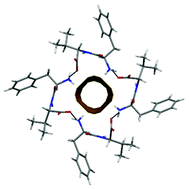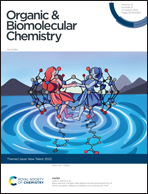Dipeptide self-assembly into water-channels and gel biomaterial†
Abstract
Dipeptides are convenient building blocks for supramolecular gel biomaterials that can be produced on a large scale at low cost and do not persist in the environment. In the case of unprotected sequences, hydrophobicity is a key requirement to enable gelation, with Phe–Phe standing out for its self-assembling ability. Conversely, more hydrophilic sequences such as homochiral dipeptides Phe–Val and Val–Phe neither fibrillate nor gel aqueous buffers and their crystal structures reveal amphipathic layers. In this work, we test emerging rules for the design of self-assembling dipeptides using heterochiral Phe–Val and Val–Phe. Each dipeptide is characterized by 1H- and 13C-NMR, LC-MS, circular dichroism, infrared and Raman spectroscopies, rheology, electron microscopy, and single-crystal X-ray diffraction. In particular, D-Phe–L-Val is the first heterochiral dipeptide to self-assemble into supramolecular water-channels whose cavity is defined by four peptide molecules arranged head-to-tail. This minimalistic sequence is devoid of amyloid character as probed by thioflavin T fluorescence and it displays excellent biocompatibility in vitro. The dataset provided, through comparison with the literature, significantly advances the definition of molecular design rules for minimalistic unprotected dipeptides that self-assemble into water-channels and biocompatible gels, to assist with the future development of supramolecular biomaterials with fine control over nanomorphological features for a variety of applications.

- This article is part of the themed collection: New Talent


 Please wait while we load your content...
Please wait while we load your content...